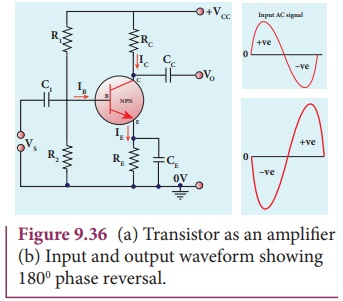Bipolar Junction Transistor [BJT] - Transistor as an amplifier | 12th Physics : UNIT 10a : Semiconductor Electronics
Chapter: 12th Physics : UNIT 10a : Semiconductor Electronics
Transistor as an amplifier
Transistor as an amplifier
A transistor operating in the active
region has the capability to amplify weak signals. Amplification is the process of increasing the signal strength
(increase in the amplitude). If a large amplification is required, the
transistors are cascaded with coupling elements like resistors, capacitors, and
transformers which is called as multistage amplifiers.
Here, the amplification of an
electrical signal is explained with a single stage transistor amplifier as
shown in Figure 9.36(a). Single stage indicates that the circuit consists of
one transistor with the allied components. An NPN transistor is connected in the
common emitter configuration.

To start with, the Q point or the
operating point of the transistor is fixed so as to get the maximum signal
swing at the output (neither towards saturation point nor towards cut- off). A
load resistance, RC is
connected in series with the collector circuit to measure the output voltage.
The capacitor C1 allows only the ac signal to pass through. The
emitter bypass capacitor CE provides a low reactance path to the
amplified ac signal. The coupling capacitor CC is used to couple one
stage of the amplifier with the next stage while constructing multistage
amplifiers. VS is the
sinusoidal input signal source applied across the base-emitter. The output is
taken across the collector-emitter.
Collector current, IC =

Applying Kirchhoff ’s voltage law in
the output loop, the collector-emitter voltage is given by
VCE =VCC - IC RC
Working of the amplifier
• During the positive half cycle
Input signal (Vs ) increases the forward voltage across the emitter-base. As a result,
the base current (IB ) increases.
Consequently, the collector current (IC
) increases β times. This increases the voltage drop across RC (IC RC ) which in turn decreases the
collector-emitter voltage (VCE
). Therefore, the input signal in the positive direction produces an
amplified signal in the negative direction at the output. Hence, the output
signal is reversed by 180Âş as shown in Figure 9.36(b).
• During the negative half cycle
Input signal (Vs) decreases the forward voltage across the
emitter-base. As a result, base current (IB
) decreases and in turn increases the collector current (IC ) . The increase in
collector current (IC )
decreases the potential drop across RC
and increases the collector-emitter voltage (VCE ). Thus, the input signal in the negative direction
produces an amplified signal in the positive direction at the output.Therefore,
180Âş phase reversal is observed during the negative half cycle of the input
signal as well as shown in Figure 9.36(b).
Related Topics